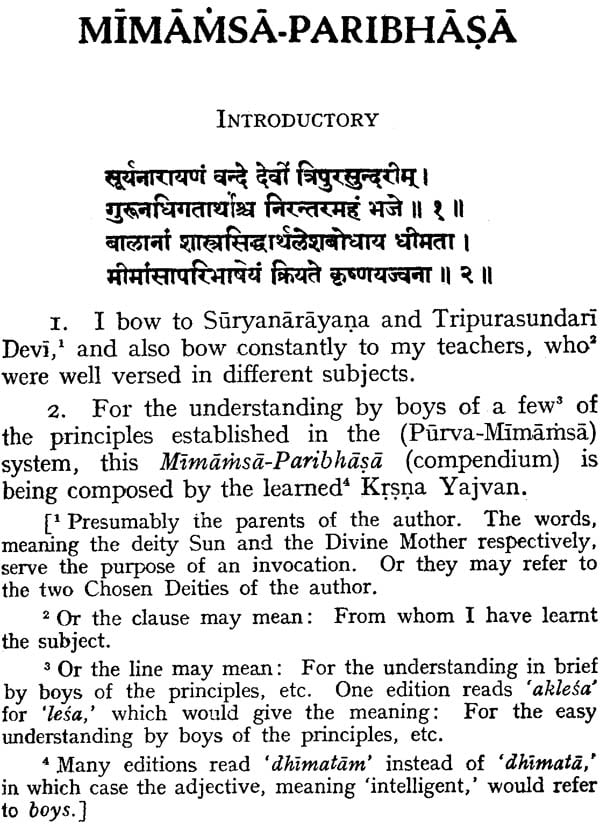
Mimamsa Paribhasa of Krsna Yajvan
Book Specification
| Item Code: | NAD796 |
| Author: | Swami Madhavananda |
| Publisher: | ADVAITA ASHRAM KOLKATA |
| Language: | English |
| Edition: | 2019 |
| ISBN: | 8175051140 |
| Pages: | 96 |
| Cover: | Paperback |
| Other Details | 7.0 inch X 5.0 inch |
| Weight | 90 gm |
Book Description
The Purva-Mimarhsa is one of the six systems of Hindu philosophy which have come down to us from hoary antiquity. They fall into three groups, viz., Nyaya and Vaisesika, Sarnkhya and Yoga, Mimamsa and Vedanta. Each has its special field of inquiry, where it zealously defends its findings, but in other matters it is content to borrow from the others. The word purva means initial, and mimamsa, a reasoned conclusion. The system is so called because it aims at a rational settlement of the doubtful points in the initial or ritualistic• portion (karma-kanda) of the Vedas, while the Uttara-Mimamsa or Vedanta deals with their final or philosophical portion (jnana-kanda), consisting of the Upanisads,
Some millenniums ago, sacrifices to different deities formed a very important part of the religious life of the cultured sections in India, and for a proper performance of them the Mimamsa was indispensable. Even to-day it has great influence over Hindu society, inasmuch as the Vedas and Smrtis, which prescribe religious duties for the Hindus, as also Hindu law, are interpreted according to the tenets of the Mimamsa. But as its speculative side was intended to serve the purpose of rituals, it is neither comprehensive nor very convincing as a philosophy.
According to the Mimamsa (as also the Vedanta), the Vedas are eternal, being only revealed to certain rsis or seers. As such they are free from human defects, and their authority is unquestionable. The Mimamsa goes so far as to say that even words are eternal and their meanings fixed. Unlike the Nyaya, both systems regard knowledge as self-valid that is as carrying conviction of its truth unless invalidated later. But the Mimamsa is sharply at variance with the Vedanta both in its' objective and method. For it is an inquiry into righteous action (dharma); it believes in a real objective universe as well as in a plurality of selves, although these are admitted as eternal and omnipresent; and it glorifies heaven, to which the performance of rituals is held to be the way. But the Vedanta in its highest or monistic phase is an inquiry into Brahman or the Supreme Reality; it looks upon the whole phenomenal world as illusory; and it exhorts us to strive for Liberation, consisting in the realisation of our essential oneness with Brahman, through knowledge, to which devotion and self- less work are indirect helps. The whole emphasis of the Mimarnsa is on the mechanical performance of rites, and it has no use for God as the author of the periodical manifestation and dissolution (srsti and pralaya) of the world, nor does it believe in them.
The basic work on the Mimarnsa is the Piirua- Mimanisa Sutras, or-Aphorisms, of Jaimini (probably 200 B.C.), which has been commented on by Sabara Svarnin. Two other illustrious thinkers, Kumarila Bhatta and Prabhakara-c-the latter supposed to be a pupil of the former-have written expositions on this work and have come to found two distinct schools of this system. Subsequent writers on the Mimamsa have more or less elaborated the views of these two masters, notably Kumarila, who tried to bring the Mimamsa as close as possible to the Vedanta.
Some knowledge of the canons of the Mimamsa is essential for an understanding of the philosophical literature of India. The Mimamsa-Paribhasa, which means, "A lucid exposition of the Mimamsa;" is the smallest popular treatise on the subject. Very little is known of its author, Krsna Yajvan; but his book, setting forth some of the salient ritualistic principles of the system, culled from Jaimini's Sutras is a veritable boon for beginners. Somewhat more comprehensive is the Artha-Samgraha by Laugaksi Bhaskara, and still more so is the Mimamsa-Nyaya- Prakiisa (or Apadevi) by Anantadeva. Of these, the former has got two English translations, but the Mimamsa-Paribhasa has none. Hence the present attempt.
Mtmamsa-Paribhasa was first translated and annotated by Swami Madhavananda of revered memory. He became the ninth President of the Ramakrishna Math and the Ramakrishna Mission. A profound scholar, he has translated a number of Sanskrit scriptures into English, his magnum opus being the translation of the Brhadaranyaka Upanisad with the commentary of Sankaracarya, There are several other translations of Sanskrit treatises by him, all published by us.
In his learned 'Foreword' to this rare but popular treatise on this subject, the translator has pointed out its importance in the study of the Mimamsa (more correctly, Purva-Mimamsa system of Indian Philosophy. There is hardly any more useful information that can be added by us.
The first edition of this book was published by the Ramakrishna Mission Saradapitha, Belur Math. It was long out of print. At our request, the present authorities of the Saradapitha have accorded permission to us to bring out this second edition, for which our grateful thanks are due to them.
| Introductory | 1 |
| Varieties of Brahmana Sentences | 3 |
| The Injunction Regarding Performance | 8 |
| Three Kinds of Injunctions | 19 |
| Six Tests of a Subsidiary | 23 |
| What is a Subsidiary | 31 |
| Two Main Divisions of Subsidiary Rites | 34 |
| A Fourfold Division of Subsidiary Rites | 41 |
| How An Injunction Function | 46 |
| Four Tests of Names | 56 |
| Corroborative Statements | 69 |
| Sacred Texts | 73 |
| Criteria of a Difference of Rite | 82 |
| Threefold Vedic Subject-Matter | 87 |
| Order | 89 |











